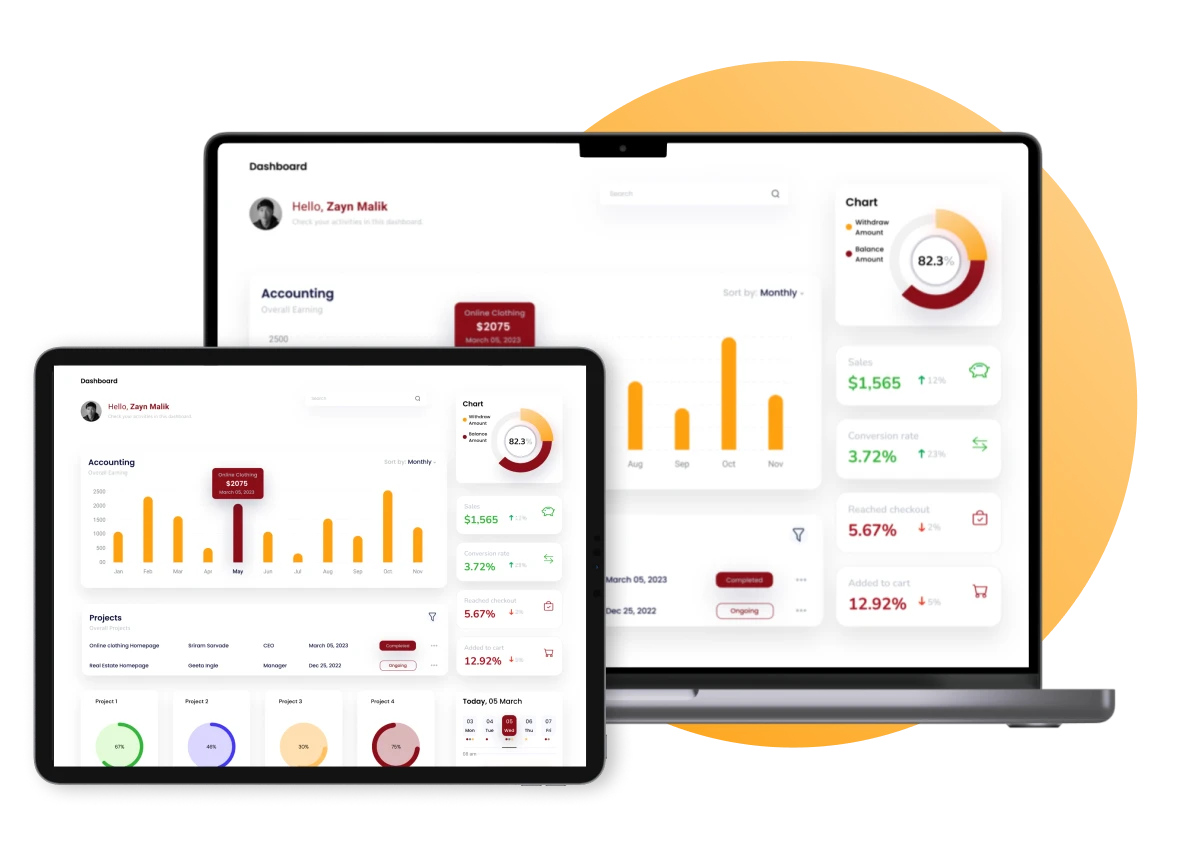Is your business running out of cash even when sales are strong? You are not alone. Many negosyante face this challenge and struggle to pinpoint the cause. The truth is that having good sales does not always mean you will have enough cash to cover your expenses. This is where a cash flow projection becomes essential.
It helps you predict money movement, prepare for shortages, and make smarter financial decisions. Read on to discover how this simple tool can give you the financial clarity your business needs to grow.
Key Takeaways
|
Table of Contents
What is Cash Flow Projection?
A cash flow projection is a financial tool that estimates the money expected to come into and go out of your business over a specific period. It works by estimating income and expenses to help ensure your business has enough cash to meet its obligations and avoid shortages.
For example, imagine a retail store preparing for the holiday season. By creating a cash flow projection, the owner can estimate higher sales in December and plan for increasing stocks. At the same time, they can anticipate recurring expenses like rent and staff wages to ensure they maintain enough cash.
Why is Cash Flow Projection Important?
Creating a cash flow projection is one of the smartest financial moves you can make for your business. It provides a clear picture of your current and future cash position. This can help you make informed decisions that keep your business financially stable.
By understanding where your money is coming from and where it’s going, you gain the clarity and control needed to grow and sustain your business. Three whys you should know are:
- Plan for expenses efficiently: With a cash flow projection, you can schedule major purchases, like upgrading equipment or stocking up on inventory, at the right time. It also helps you set aside funds for unexpected costs, ensuring your business remains prepared for surprises.
- Anticipate shortages early: Knowing when your cash might dip allows you to act before it becomes a crisis. You can arrange loans, negotiate payment terms, or adjust spending to keep your business running smoothly without financial stress.
- Identify spending and revenue patterns: A projection helps you track trends, such as when your revenue peaks or your expenses rise. For instance, you might notice that utility bills spike during summer or sales surge in the holiday season, allowing you to adjust accordingly.
By leveraging these insights, you can optimize your financial strategy and avoid costly mistakes. Cash flow projections not only protect your business from unexpected challenges but also empower you to seize growth opportunities confidently.
You may be wondering how you can easily create a cash flow projection now. There are two ways: you can use accounting software, or alternatively, you can follow these 7 easy steps!
How to Create an Accurate Cash Flow Projection
Creating a cash flow projection helps you stay on top of your finances and avoid unexpected shortages. Here’s how you can build it step by step:
1. Bring forward your starting balance
Start with your cash balance from the previous month. For example, if your ending balance is ₱100,000, this becomes your starting balance for the new month.
2. Estimate monthly sales
Forecast the income you expect to receive. If you have ₱200,000 in pending invoices and expect to collect 60%, add ₱120,000 as revenue. Be realistic to ensure accuracy.
3. Include other revenue source
List additional income beyond sales, such as rental income, interest, or monthly recurring revenue. For instance, renting office space for ₱10,000 monthly adds to your revenue projection.
4. Lost regular expenses
Account for all recurring expenses, such as rent, utilities, and staff wages. For example:
- Rent: ₱20,000
- Utilities: ₱5,000
- Staff salaries: ₱50,000
5. Add seasonal or one-time costs
Include irregular expenses like annual fees or bonuses. For example, if your business pays ₱30,000 annually for professional services, allocate it to the relevant month only.
6. Calculate net cash flow
Subtract total expenses from total revenue to determine your net cash flow. This figure tells you if you have a surplus to invest or a deficit to address.
7. Update your ending balance
Add your net cash flow to the starting balance to calculate your ending balance. Use this as your starting point for the next month’s projection.
By following these steps, you can create a reliable cash flow projection that helps you manage finances, prepare for challenges, and seize opportunities for growth. Let’s talk about the benefits of doing all of these next.

Benefits of Cash Flow Projection
Maintaining a cash flow projection offers several key benefits that can significantly enhance your business’s financial health:
- Better decision-making
By understanding your projected cash inflows and outflows, you can make smarter financial choices, such as determining the best times to invest in new equipment or when to reduce spending. - Transparent spending control
A realistic budget based on expected income helps prevent overspending. This enables you to prioritize essential expenses and savings, ensuring your business remains financially stable. - Prevent financial risks
Regularly updating your cash flow projection allows you to spot potential financial issues, like periods where expenses may exceed income. Early detection enables you to take proactive measures to mitigate these risks. - Avoid cash shortages
Forecasting your revenue helps you anticipate potential cash shortfalls. This foresight allows you to explore options such as securing loans or adjusting payment terms to maintain adequate cash flow.
By leveraging these benefits, you can strengthen your business’s financial foundation and navigate challenges with greater confidence.
Tips for Filipino Business Owners
Cash flow projections are a game-changer for businesses across industries in the Philippines. Challenges like fluctuating sales during typhoon seasons or increased demand during holiday rushes can significantly impact your cash flow.
By forecasting your income and expenses, you can confidently handle these situations without compromising operations. To make the most of your cash flow projections, focus on these key tips:
- Use Historical Data
Analyze your past financial performance to identify patterns in income and expenses. For example, if your store experiences higher sales during Christmas but slower sales during the rainy season, include these trends in your projection to prepare for leaner months. - Plan for Seasonal Costs
Account for expenses that are not regular, such as holiday bonuses, back-to-school promotions, or storm-related repairs. These one-time costs can add up, so including them in your projection ensures you have funds ready when needed. - Set Aside Emergency Funds
Unpredictable events like typhoons or sudden market shifts can strain your finances. Build a cash buffer in your projections to cover unforeseen expenses and keep your business running smoothly. - Use Technology
Use accounting or financial management software to simplify the process and reduce errors. Tools like these can automate calculations, update forecasts in real-time, and provide insights that manual tracking might miss. - Review and Adjust Regularly
Your business environment changes constantly, so revisit your projections at least monthly. Updating your forecast ensures it reflects your current financial situation and helps you adapt to new challenges or opportunities.
By following these tips, Filipino business owners can confidently navigate financial uncertainties and make well-informed decisions. Cash flow projections not only keep your business afloat during tough times but also position it for growth and success.
Instantly Manage Cash Flow Projection with HashMicro Accounting Software
We’ve previously discussed the importance of using technology to simplify cash flow management. Now, the technology that can make this process seamless for your business is HashMicro Accounting Software. Designed for businesses in the Philippines in mind, this software will help you handle cash flow projections with ease.
Some of its features are:
- Automated Bank Integrations to Save Time and Eliminate Errors
Link your bank accounts for seamless reconciliations and payments, ensuring accuracy and freeing up valuable time for business growth. - Detailed Cashflow Reports for Confident Financial Planning
Track your cash inflow and outflow in real-time to avoid shortages, seize opportunities, and make proactive financial decisions with ease. - Profit & Loss Comparison with Budgets to Optimize Resources
Analyze how your actual performance aligns with your budget and forecasts, helping you identify gaps and stay on track with your financial goals. - Multi-Level Analytics to Drive Smarter Business Decisions
Compare financial data across projects, branches, or departments to pinpoint profit sources and allocate resources for maximum impact. - Effortless Tax Compliance with eFaktur & DJP Integration
Generate and manage tax invoices directly from the system to simplify compliance, reduce administrative burdens, and avoid costly penalties.
By using comprehensive accounting software Philippines, such as HashMicro, you’re not just managing your cash flow. You’re taking full control of your business finances. This powerful tool empowers you to make smarter financial decisions, avoid shortages, and set your business up for success.
Conclusion
A cash flow projection is essential for keeping your business financially stable and prepared. It helps you manage income and expenses efficiently, ensuring you have the cash to handle obligations and seize growth opportunities. Without it, financial surprises could put your operations at risk.
Start taking control of your business finances with a reliable and accurate cash flow projection today. Make it even easier using HashMicro Accounting Software, designed to streamline the process and ensure accuracy. Try the free demo now and discover how it can transform financial management.

Frequently Asked Questions
-
How do you calculate project cash flow?
To calculate project cash flow, subtract total expenses from total income during a specific period. Include revenue sources, regular and seasonal costs, and use a starting balance to track surplus or deficit.
-
How do you do a cash flow forecast?
To create a cash flow forecast, estimate income and expenses for a future period using past data. Regularly update your forecast to adapt to financial changes and maintain accuracy.
-
What is an example of cash flow?
An example of cash flow is a store earning ₱150,000 in sales while spending ₱100,000 on costs. The net cash flow of ₱50,000 helps the owner plan for future expenses or investments.


































